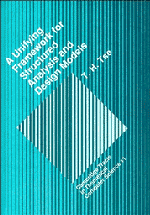 A Unifying Framework for Structured Analysis and Design Models
A Unifying Framework for Structured Analysis and Design Models Published online by Cambridge University Press: 28 January 2010
Structured analysis and design methodologies have been recognized as a popular and powerful tool in information systems development. A complex system can be specified in a top-down and graphical fashion, enabling practitioners to visualize the target systems and communicate with users much more easily than by means of conventional methods. As a matter of fact, the structured methodologies have been designed by quite a number of distinct authors, each employing a number of models which vary in their graphical outlook. Different models are found to be suitable for different stages of a typical systems life cycle. A specification must be converted from one form to another during the development process. Unfortunately, however, the models are only derived from the experience of the authors. Little attempt has been made in proposing a formal framework behind them or establishing a theoretical link between one model and another.
A unifying framework is proposed in this book. We define an initial algebra of structured systems, which can be mapped by unique homomorphisms to a DeMarco algebra of data flow diagrams, a Yourdon algebra of structure charts and a Jackson algebra of structure texts. We also find that the proposed initial algebra as well as the structured models fit nicely into a functorial framework. DeMarco data flow diagrams can be mapped by a free functor to terms in the initial algebra, which can then be mapped to other notations such as Yourdon structure charts by means of forgetful functors.
To save this book to your Kindle, first ensure [email protected] is added to your Approved Personal Document E-mail List under your Personal Document Settings on the Manage Your Content and Devices page of your Amazon account. Then enter the ‘name’ part of your Kindle email address below. Find out more about saving to your Kindle.
Note you can select to save to either the @free.kindle.com or @kindle.com variations. ‘@free.kindle.com’ emails are free but can only be saved to your device when it is connected to wi-fi. ‘@kindle.com’ emails can be delivered even when you are not connected to wi-fi, but note that service fees apply.
Find out more about the Kindle Personal Document Service.
To save content items to your account, please confirm that you agree to abide by our usage policies. If this is the first time you use this feature, you will be asked to authorise Cambridge Core to connect with your account. Find out more about saving content to Dropbox.
To save content items to your account, please confirm that you agree to abide by our usage policies. If this is the first time you use this feature, you will be asked to authorise Cambridge Core to connect with your account. Find out more about saving content to Google Drive.